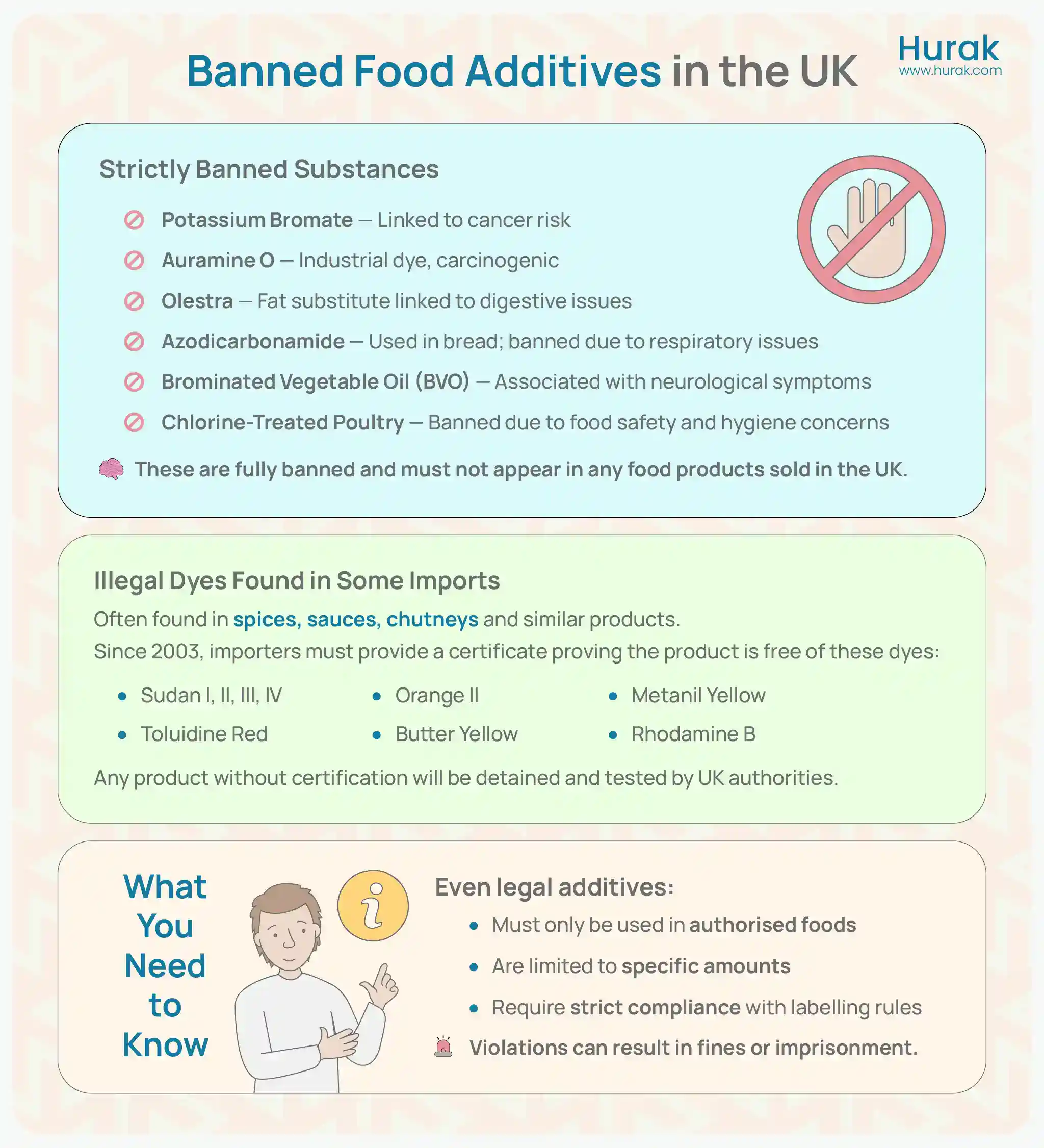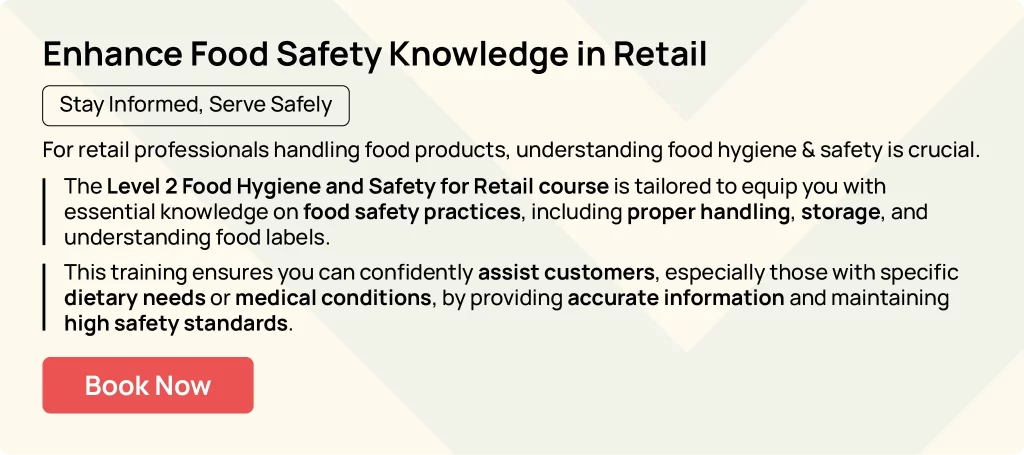Ever wonder why your grandma used to salt meat and pickle everything?
Why did older generations in the UK salt meats, make jams by the jar, or pickle vegetables in vinegar?
These weren’t just traditional recipes – they were clever ways to preserve food long before fridges existed.
Today, we still preserve and enhance food, but instead of using salt and sugar, it often involves something listed as “E202 or Red 40” on a label. These are food additives – and they’ve been part of our meals, in one form or another, for centuries.
What are food additives?
Food additives are substances added to food to enhance its shelf life, flavour, appearance, or texture. While the term additives can sometimes sound worrying, not all additives are artificial or unsafe. In fact, many additives are natural and carefully regulated to ensure they are safe for consumption. Both natural additives, such as beetroot red, and synthetic additives, like aspartame, play important roles in modern food manufacturing, helping to maintain food quality and safety.
Note: According to the Food Standards Agency (FSA), food additives must pass safety checks and be approved before they can be used in the UK.
Why are food additives used?
Food additives serve a variety of purposes, such as:
- Preserving freshness (e.g., sorbates in baked goods)
For more information on food preservation, read our article
- Enhancing flavour (e.g., monosodium glutamate in savoury snacks)
Learn more about food flavour in:
- Improving appearance (e.g., food dyes like Yellow 5)
- Achieving consistent texture (e.g., emulsifiers in sauces)
These additives make food look better, last longer, and taste more appealing, especially in mass-produced items.
The evolution of food additives
Food additives aren’t a modern invention. They’ve simply changed with time, from natural ingredients used at home to approved chemical compounds in food production.
Ancient methods: Nature’s own preservatives
Long before food factories and supermarkets, people preserved food using what was readily available. Common traditional methods in the UK included:
- Salt-curing fish or meats
- Smoking meats in chimneys
- Vinegar pickling vegetables
- Honey or sugar in jams
These not only extended shelf life but also enhanced flavour.
Middle ages: Flavour meets function
As trade expanded, spices and sugar became more widely available in Britain. They weren’t just for taste; they helped delay spoilage, too.
- Cloves, pepper, and cinnamon masked unpleasant odours
- Sugar was used in fruit preserves and to coat food items
Industrial era: The rise of chemical additives
With mass production came the need for longer shelf lives and consistent quality. This led to the use of:
- Benzoates to prevent mould
- Sulphites in dried fruits and wine
- Artificial food dyes to enhance colour consistency
It was during this period that food additives began to be formulated in laboratories and regulated.
Classification of food additives: Natural vs Artificial
Food additives can be broadly categorised into two main types: natural and artificial. While both serve the same purpose of improving the quality, safety, and appeal of our food, they differ in origin, processing, and public perception.
In the UK, you’re likely using or consuming both types daily – whether it’s the citric acid in your lemonade, or aspartame in your sugar-free chewing gum.
Let’s break down the key differences.
Natural vs Artificial additives: At a glance
| Feature | Natural Additives | Artificial Additives |
| Source | Derived from natural ingredients (plants, animals, or minerals) | Created synthetically through chemical processes |
| Examples | Beetroot red (E162), Citric acid, Lecithin (from soy), Pectin (from apples) | Aspartame (E951), Tartrazine (E102), Sodium benzoate (E211) |
| Common Uses | Used in juices, jams, yoghurts, and ready meals | Found in diet drinks, crisps, sweets, and processed foods |
| Consumer Perception | Often seen as safer or “clean label” | Sometimes viewed with caution or concern |
| Daily UK Examples | Homemade jam using lemon juice (citric acid), Vinegar in chutneys | Soft drinks with E-numbers, Colourings in crisps and confectionery |
While natural additives are often considered more wholesome, artificial additives are widely used in the UK food industry for consistency, affordability, and longer shelf life.
In the next section, we’ll explore the different types of additives you might find on labels – from flavour enhancers to preservatives.
Stay compliant: Train to handle food additives safely
Working with food additives?
You must know the rules.
If you’re in the hospitality or food service industry, you’re legally required to follow food hygiene and allergen regulations. The following two government-aligned courses are highly recommended:
🔹 Level 3 Food Hygiene and Safety for Supervisors
Train to supervise others and understand food hygiene laws under EU Regulation 852/2004.
🔹 Food Allergy Awareness Course
Protect customers from harmful allergens and ensure you’re following the correct labelling and contamination practices.
These courses meet the Environmental Health Officer’s standards and are essential for anyone working with food or food additives in the UK
Types of food additives
Food additives are intentionally added to food to improve its shelf life, flavour, texture, or appearance. You’ll find them in nearly everything you eat – from everyday basics like sliced bread or breakfast cereals to pricier products like ready-made lasagne, gourmet sauces, or smoked meats.

These additives are tightly regulated in the UK and must pass safety checks before use. Let’s look at the main types of food additives and understand them with food additives examples that you’ll be able to recognise from your own kitchen or supermarket shop.
Preservatives
Preservatives help keep food fresh for longer by slowing down spoilage caused by bacteria, mould, or yeast.
✅ Common Example: Calcium propionate (E282) is used in most packaged sliced bread to stop mould growth.
📚 Learn more in our article
Flavour Enhancers
These additives boost or intensify the flavour of food without adding their own taste.
✅ Common Example: Monosodium glutamate (MSG) is used in many ready meals and savoury crisps to enhance umami flavour.
📚 Related read: What is flavour?
Sweeteners
Sweeteners provide sweetness with fewer or zero calories compared to sugar. They are especially common in “diet” or “low-sugar” foods.
✅ Common Example: Aspartame is found in most diet fizzy drinks and sugar-free chewing gums.
📚 Read our article the Healthy Eating Pyramid.
Colourings (Food Colours)
These are used to restore or enhance the colour of food products. Natural and synthetic options exist.
✅ Common Example:
Red 40 (Allura Red AC) is a synthetic dye used in fruit-flavoured yoghurts and sweets.
Yellow 5 Dye (Tartrazine) is found in some lemon-flavoured soft drinks and snack foods.
Emulsifiers and Stabilisers
These keep ingredients that usually wouldn’t mix (like oil and water) blended smoothly, giving consistent texture.
✅ Common Example: Lecithin (E322) is used in mayonnaise and salad dressings to maintain a smooth texture.
Antioxidants
Antioxidants prevent fats and oils in food from going rancid, helping maintain flavour and appearance.
✅ Common Example: Ascorbic acid (Vitamin C) is used in fruit juices and cut fruits to prevent browning.
Acidity Regulators
These control the pH of food to influence flavour and preservation.
✅ Common Example: Citric acid is added to many fizzy drinks and sour sweets for a tangy flavour.
Thickeners and Gelling Agents
These change the consistency of food, giving it a thicker or more stable texture.
✅ Common Example: Pectin is used in jams and jellies to give them a smooth, gel-like consistency.
The safety of food additives is a serious concern for both consumers and professionals in the food industry. That’s why regulatory bodies around the world are responsible for reviewing and controlling the additives allowed in our food.
How Are Food Additives Regulated in the UK?
In the UK, food additives are strictly monitored to ensure they’re safe to consume and used appropriately. The Food Standards Agency (FSA) is the leading authority responsible for overseeing food additives in England, Wales, and Northern Ireland. They collaborate with other scientific bodies, such as the European Food Safety Authority (EFSA), to evaluate the safety of additives.
Let’s break down the Food Additive Regulations in the U.K. for easy understanding:
Scientific Testing and Approval
Before an additive can be used in food:
- It goes through a scientific safety assessment.
- This is typically done by EFSA, which assesses the amount that people can safely consume.
- If proven safe, it may be authorised for use.
For example, food colourings, preservatives, and emulsifiers all undergo this process before reaching supermarket shelves
Only Approved Additives Are Allowed
In the UK:
- Only pre-approved additives can be used in food products.
- Each one is assigned an E number (e.g. E102, E621).
- The list also specifies what foods they can be used in and how much is allowed
Must Meet Strict Criteria
To be approved, a food additive must:
- Be proven safe for health.
- Serve a technological need (like preventing spoilage or improving texture).
- Not mislead the consumer (e.g. making food look fresher than it is).
- Offer a benefit to consumers
Different Foods, Different Rules
Not every additive can be used in all foods. For instance:
- Some preservatives are allowed in meats, but not in dairy.
- Certain colourings might be fine for sweets, but banned in baby food.
This protects people with allergies and other sensitivities
What About After Brexit? UK vs EU Rules
Since leaving the EU:
- Great Britain (comprising England, Wales, and Scotland) now makes its own decisions regarding food additives. This means that new additives approved by the EU may not be automatically legal in Great Britain.
- The FSA reviews the safety of additives, and UK ministers authorise them.
- However, the EFSA still plays a role in scientific assessments, and the UK often aligns with EU standards.
This divergence means some products approved in the EU may not appear on UK shelves, or vice versa.
Northern Ireland continues to follow EU food laws under the Northern Ireland Protocol.
Do you know what the “E” in E Numbers signify?
Decoding Food Additive Labels
The “E” in E numbers stands for “Europe.” These codes are assigned to food additives that have been evaluated and approved for use within the European Union and the UK. An E number indicates that the additive has passed rigorous safety assessments and is deemed safe for consumption. For instance, E100 refers to Curcumin, a natural yellow colouring derived from turmeric.
For more information, check out the FSA article on approved additives and E numbers
Banned food additives in the UK
The UK has strict laws regarding the use of additives in food. Any additive that poses a risk to health is either restricted or banned outright. This can include additives linked to cancer, hyperactivity in children, or other serious health concerns.
Strict labelling rules also apply. Foods imported into the UK from outside the EU or UK must meet specific documentation and labelling standards, or they risk being detained and tested.

Is Red 40 Banned in the UK?
Red 40, also known as Allura Red AC (E129), is a synthetic dye commonly found in sweets, drinks, and processed foods in the U.S.
But is Red 40 banned in the UK?
No – Red 40 is not banned in the UK, but it is heavily regulated. Products containing Red 40 must carry a warning label, especially due to concerns about hyperactivity in children.
“May have an adverse effect on activity and attention in children” – this warning must appear on foods with certain artificial colours, including Red 40.
Because of these strict regulations, many UK manufacturers avoid using it altogether. If you’re importing foods from the U.S. or other non-EU countries, be cautious — products with Red 40 might not meet UK labelling standards.
Why Some American Foods Are Banned in the UK
In the US, food additives can be approved without FDA review if they’re considered Generally Recognised as Safe (GRAS) by experts. This lets manufacturers decide on safety themselves.
In contrast, the UK requires strict approval and scientific testing before any new additive can be used, prioritising consumer safety.
Real-World Example: Banned American Products in the UK
A notable instance highlighting these regulatory differences involves the importation of certain American candies and beverages into the UK. In recent years, UK authorities have seized products like Mountain Dew and Jolly Ranchers due to the presence of additives banned under UK law, such as brominated vegetable oil (BVO) and certain artificial dyes.
These actions underscore the UK’s commitment to stringent food safety standards and the challenges posed by differing international regulations on food additives.
Conclusion: Why Food Additive Regulations Matter
Food additives have long been used to preserve and enhance the quality of food. In the UK, strict regulations ensure their safety. Whether natural or artificial, understanding additives helps you make informed decisions about your food choices.
The UK takes food safety very seriously, especially when it comes to additives. While additives are almost essential in today’s fast-paced world of pre-cooked and packaged foods, not all additives are created equal. Some artificial ingredients may pose health risks, which is why the UK follows one of the strictest regulatory frameworks in the world.
From detailed safety assessments to strict usage guidelines, every additive in your food is carefully evaluated to ensure it is safe for consumption. Unlike in some countries, where approvals can rely on internal company decisions, the UK applies the precautionary principle to prioritise your health.
Learn More with Hurak’s Certified Food Safety Courses
If you want to stay compliant and informed, check out Hurak’s accredited food hygiene courses that cover essential food safety practices, including how to understand additives, allergens, labelling, and more:
Seeking a course tailored to your specific role?
Explore our Food Hygiene & Safety Courses now!
FAQs
What are additives?
Additives are substances added to food to improve its taste, texture, shelf life, or appearance.
What are food additives?
Food additives include natural or artificial ingredients like preservatives, sweeteners, and food colours that enhance food quality and safety.
Are food additives safe?
Yes, approved food additives in the UK are regulated and tested by the Food Standards Agency for safety.
What are some food additives examples?
Examples include citric acid in soft drinks, lecithin in sauces, and aspartame in sugar-free gums.
What is Red 40?
Red 40 is a synthetic food dye used in sweets and yoghurts to enhance red colour; it’s approved for use in the UK.
Is Yellow 5 dye allowed in the UK?
Yes, Yellow 5 (Tartrazine) is permitted in the UK but must be clearly labelled due to possible sensitivity in some people.
What are food colours used for?
Food colours restore or enhance the natural appearance of food, often used in drinks, snacks, and desserts.
Are food dyes harmful?
Most food dyes approved in the UK are considered safe when used within legal limits, but some may affect sensitive individuals.
What foods are banned in the UK due to additives?
Foods containing non-approved additives like brominated vegetable oil (BVO) or certain artificial dyes are banned in the UK.
How are food additives labelled in the UK?
They are listed by function (e.g., preservative) and E number or name on ingredient labels, ensuring transparency for consumers.





